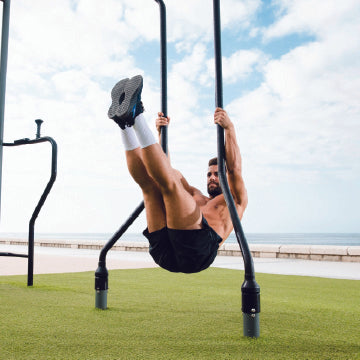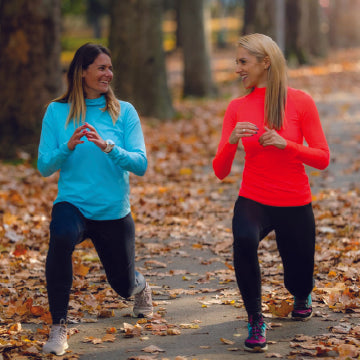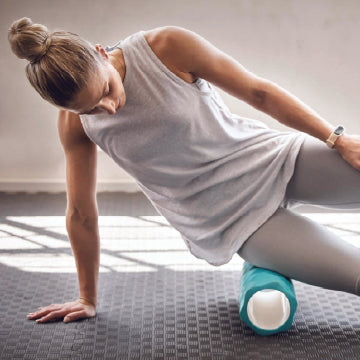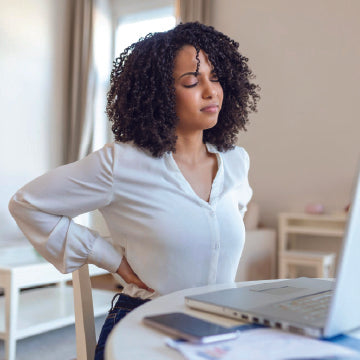
5 Hip Bursitis Exercises to Avoid
Some movements and exercises can make hip bursitis worse. Scroll down for five hip bursitis exercises to avoid until your hip has healed.
Author:START READING
Related Articles
- Hip Bursitis: Injury Overview
- The Best Hip Bursitis Treatments
- The Best Hip Bursitis Exercises & Stretches
- Hip Bursitis Exercises to Avoid
In the United States, hip bursitis affects 15% of women and 8.5% of men. In other words, it's an incredibly common condition. But what is hip bursitis? What are some hip bursitis exercises to avoid?
Hip bursitis is inflammation of the bursa. There are two major bursa in the hips. The bursa are responsible for cushioning the hip joints, and when they get inflamed, they can't do their job as effectively.
It can be caused by repetitive activities, poor posture, or underlying conditions. Symptoms include hip pain, tenderness, and swelling. Certain risk factors include age, overuse, and specific conditions like arthritis.
We're here to break down some things you should avoid if you suffer from hip bursitis. Read on to learn more.

1. High-Impact Activities
High-impact exercises can be great for burning calories and building strength and endurance, but they also tend to be exercises to avoid with hip bursitis.
During high-impact activities, the repetitive pounding and force exerted on the hip joint can cause excess friction and pressure on the bursa. This continuous stress may irritate the bursa, leading to inflammation and exacerbating your hip bursitis symptoms.
The rapid and forceful movements involved in activities like running and jumping can contribute to the wear and tear on the hip joint. This is particularly challenging for individuals with hip bursitis.
Therefore, modifying exercise routines to include low-impact alternatives or incorporating appropriate rest and recovery periods is necessary when it comes to managing and preventing the worsening of bursitis symptoms.
Specific High-Impact Hip Bursitis Exercise to Avoid
When we discuss high-impact exercises, what exactly do we mean? High-impact exercises come in many forms.
You want to avoid anything that involves excessive jumping, including things like jumping jacks, box jumps, jump squats, and burpees. Even jumping rope isn't a good idea when you're coping with hip bursitis.
You also want to avoid running, kickboxing, and high-impact aerobics. These things are great for your heart but terrible for your joints. They'll make hip conditions worse.
Low Impact Alternatives
So does that mean that cardio exercise is off the table with hip bursitis? Not at all. There are plenty of low-impact alternatives that are far safer for your hips and still good for your heart.
Walking is great for people with hip bursitis, but make sure you stick to short distances when you're first getting started. Maintain a slow and steady pace and consult with your doctor before speeding up.
Swimming is fantastic for your body, including your joints. It's perfectly safe for people who are treating hip bursitis.
You may be wondering, "Is cycling good for hip bursitis?"
The answer is yes!
Stationary or recumbent cycling is gentle on the hips and offers great cardiovascular benefits, so it's good for your heart as well. Adjust the seat and handlebars for proper alignment to minimize strain.

2. Deep Squats and Lunges
Deep squats and lunges are fantastic for your legs, glutes, and even abdominal muscles. However, they can also exacerbate hip pain. This is because they cause deep flexion of the hip joint.
Deep flexion refers to bending a joint to a large extent, often bringing the bones closer together. In the context of the hip joint, deep flexion involves bending the hip at a sharp angle, such as bringing the knee toward the chest. This movement can compress the bursa, leading to more inflammation and pain.
Alternatives to Deep Squats and Lunges
Does this mean that you have to skip leg day? Not at all. Now that you know what aggravates hip bursitis when you're doing your squats, you can find safer alternatives.
You can do modified squats that don't go as deep. These squats won't hit all of the same muscles, but they'll be far better for your hips.
Bridges or hip thrusts can also be okay for individuals with hip bursitis, but you should talk to your doctor before adding weights or resistance bands. This exercise is fantastic for the glutes.
Leg raises work the muscles in a different way, but they're great for your legs. They shouldn't cause the same pain and discomfort as deep squats and lunges, but you'll still feel your muscles working.

3. Leg Presses and Romanian Deadlifts
Leg presses and Romanian deadlifts can be fantastic for your body, but not if you have hip bursitis. Unfortunately, these powerful movements can cause serious pain and even damage.
In a leg press exercise, the exerciser sits or lies on a machine with their back against a padded seat and pushes a weighted platform away using their legs. The hip joint undergoes flexion during this movement, and this puts the hips under substantial pressure.
The pressure and compression can lead to irritation and inflammation of the bursa, intensifying hip bursitis symptoms.
Romanian deadlifts involve hinging at the hips while keeping the legs almost straight. This exercise targets the hamstrings, glutes, and lower back.
The hinging movement at the hips places stress on the hip joint and surrounding muscles. If you perform this exercise with incorrect form or excessive weight, it can lead to overstretching or straining of the hip muscles and tendons.
Even with proper form, this exercise can cause muscle imbalances, which can exacerbate symptoms of hip bursitis.
Alternatives to Leg Presses and Romanian Deadlifts
Again, your leg day doesn't have to be put on hold. While there are many lower-body exercises to avoid with hip bursitis, there are also plenty of things that you can still do.
Leg extensions, hamstring curls, and glute bridges are all fantastic alternatives with or without added weight. If you choose to add weight or resistance to these exercises, make sure you consult with your doctor first.

4. Outer Hip Foam Rolling
While foam rolling is a common technique for muscle recovery and flexibility, there is a misconception that it is always beneficial. In the context of hip bursitis, aggressive foam rolling over the outer hip area can exacerbate the condition instead of providing relief. This is because forceful pressure on the inflamed bursa can lead to more inflammation and pain.
Foam rolling involves using body weight to apply pressure to specific areas. When you apply pressure forcefully over an inflamed bursa, it can stimulate an inflammatory response. That excess inflammation in the bursa can lead to more pain and discomfort.
This isn't to say that foam rolling is bad, but rather that it can be problematic for people who already struggle with hip problems. People with hip bursitis should consult with their healthcare professionals or physical therapists before incorporating foam rolling into their routine. Professionals can provide guidance on safe and effective methods for addressing hip bursitis symptoms.
Alternatives to Outer Hip Foam Rolling
So what can you do instead when your body is feeling tight after a workout?
People with hip bursitis may benefit more from gentle stretching, mobility exercises, or applying ice to reduce inflammation. These approaches can be more suitable for managing hip bursitis without causing additional stress to the affected area.
You can also still foam roll. While people with hip bursitis should avoid aggressive foam rolling over the bursa, gentle foam rolling targeting other muscle groups can still be beneficial for overall muscle health and flexibility.
Focus on areas like the calves, quadriceps, hamstrings, adductors, IT band, glutes, upper back, lats, and neck. Apply gentle pressure, control your breath, and stay hydrated. If you have concerns or existing conditions, consult with a healthcare professional or physical therapist for more specific guidance on foam rolling techniques.
Foam rolling may be gentle, but that doesn't mean that it can't also be harmful. Use caution even when you're in the recovery phase of your workouts.

5. Prolonged Sitting and Lying
That's right, even resting can cause problems with hip bursitis. You need to be careful not to worsen your symptoms even while you're relaxing.
Too much sitting or lying down can exacerbate hip bursitis symptoms by subjecting the bursa to continuous compression, heightening inflammation, and increasing pain in the hip region. On that note, extended periods of inactivity contribute to stiffness and muscle weakness, further intensifying your hip bursitis-related discomfort.
The lack of movement leads to poor joint flexibility, making your normal activities challenging and exacerbating your pain while you move.
Tips for Staying Active at Rest
To soften the impact of inactivity on your hip bursitis, make sure to incorporate regular breaks, gentle stretches, and light movements into daily routines.
Frequent breaks from sitting or lying down prevent pressure on the hip joint, allowing for relief from compression on the bursa. Taking moments to stand up, stretch, or walk around every hour or so can reduce the negative effects of sitting.
Gentle stretches, including hip flexor stretches, play a key role in maintaining joint mobility and reducing stiffness. You can integrate these stretches into your routine.
Engaging in low-impact activities like walking or cycling is beneficial for promoting blood flow and preventing the hip joint from staying static. These activities not only contribute to joint health but also help you prevent muscle weakness, which can exacerbate hip bursitis symptoms.
What Aggravates Hip Bursitis?
So what is it that aggravates hip bursitis anyway?
Exerting any type of prolonged pressure on the bursa, as seen in activities like extended periods of sitting or lying down, can lead to compression and irritation of the bursa. This results in inflammation and pain. Maintaining good posture is crucial, as poor alignment alters the biomechanics of the hip joint, which will put the bursa under more stress.
Engaging in exercises with poor form or for extended periods, with too much repetition, can worsen symptoms of hip bursitis. Certain underlying medical conditions such as arthritis, gout, psoriasis, and thyroid disease can also heighten the risk of inflammation in the hip joint, making the bursa more susceptible to irritation.
Managing these contributing factors through lifestyle adjustments, proper exercise practices, and addressing underlying health conditions with your doctor can help you mitigate the impact of hip bursitis.
How to Prevent Hip Bursitis While Exercising
So we've already gone over the basics of hip bursitis: what to avoid. But what should you be doing?
To make sure your hips and the rest of your body are ready for exercise, it's important to warm up. Spend about 5-10 minutes doing light cardio, like a brisk walk, and then follow it up with dynamic stretches. After exercising, cool down for another 5-10 minutes by doing static stretches to help your muscles relax.
Always pay attention to what your body is telling you. If you feel pain while exercising, stop and give your body a rest.
Mixing up your exercises, or cross-training, is also a good idea. Avoid doing the same exercises all the time to prevent overuse injuries. Cross-training will also ensure that you don't have excessive muscle imbalances, which will help with your overall strength and stability.
To support your hips, focus on strengthening the muscles around them. Regular stretching, around 10-15 minutes, two to three times a week, can also improve flexibility and prevent stiffness.
Don't forget to take breaks from sitting. Get up and move around every 30-60 minutes to keep your hips and body in good shape. If you experience persistent pain that doesn't go away, it's essential to see a doctor for proper evaluation and guidance.
Finally, make sure you're trying to maintain a healthy weight. Not only is this good for your body as a whole, but it will also reduce strain and pressure on your hips.
Treat Your Hips Well
Coping with hip bursitis can be challenging, but if you know which hip bursitis exercises to avoid, you'll be on your way to lower levels of hip pain.
You can exercise and keep your body healthy without exacerbating your hip problems. With a healthy exercise routine, safe stretching, and gentle movements, you can maintain healthy hip joints.
When in doubt, it's always best to consult with your doctor for specific advice.
Do you have hip bursitis? Carex would love to hear more about your experience. We also invite you to check our supply of pain management aids here.
About the Author

Brandon Landgraf is the Digital Marketing Manager for Carex Health Brands. He finds passion and fulfillment in creating content that enhances, improves, and enlivens others' quality of life. All of his written work is formulated to not only offer essential advice and tips but back it with proven studies and experts. His mission is to connect with readers and provide steps to make their lives better.
About Carex Health Brands
Carex is your one-stop shop for home medical equipment and for products that assist caregivers with providing the best possible support and care for their loved ones. Carex Health Brands has been the branded leader in in-home, self-care medical products for over 35 years. Our goal is to improve the lives of our customers by bring them quality products that bring dignity back to their lives. With our three nationally distributed brands, Carex Health Brands serves national, regional and independent food, drug and mass retailers along with wholesalers, distributors and medical dealers.

